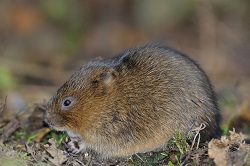Impact of rodenticides on vole and predator populations
Many farmers suffering damage to their crops and grasslands from large populations of voles attempt to control them using bromadiolone, a chemical that inhibits the coagulation of their blood. Small mustelids such as stoats and weasels are often regarded as specialist predators of voles and eating prey affected by bromadiolone treatments can expose them to the effects of the anticoagulant rodenticide (AR). The EU-funded VOLES project studied the role of AR as a ‘super-predator’ that eliminates both vole and predator populations via its transference up the food chain. Super predator modelled Society is increasingly concerned about the use of pesticides given their negative effects on biodiversity and public health. “Controlling voles with bromadiolone reduces the amount of food available to predators and increases their risk of secondary poisoning when they eat the contaminated rodents,” says project researcher Dr Javier Fernandez de Simon. However, this could result in recurrent vole outbreaks and the continuing need to control vole population by reapplying ARs. Using this form of rodent control could also impose higher production costs, thereby reducing farmers’ profits. A modelling study revealed that ARs may behave as super-predators when treatment is carried out at low vole densities (around 50 voles per hectare). But if rodenticides are applied at intermediate vole densities (around 250 voles per hectare) and in low quantities, small mustelid populations could grow and eventually regulate vole populations. When that happens, fox population densities could increase as there is no poisoning. “This treatment protocol could reduce the impact of rodenticides on predator numbers, while maintaining relatively low densities of voles, thereby benefitting farmers’ interests,” comments Dr Fernandez de Simon. Loss of voles and their predators Fieldwork data from footprint tracking tunnels coincided with the modelling results, indicating a significant decline in the abundance of stoats and weasels at sites where ARs were used between spring and autumn. In contrast, abundance of these predators did not greatly change at untreated sites. “As small mustelids can consume dead voles and we only found rodenticide residues in voles and small mustelid droppings from treated sites, we concluded that application of anticoagulant rodenticides in grasslands may generally reduce the abundance of small mustelids,” claims Dr Fernandez de Simon. Similar abundance reductions have also been previously observed with red foxes, suggesting that ARs may play the role of super-predators. VOLES’ findings represent a breakthrough in understanding the transfer of bromadiolone and its long-term effects, enabling scientists to develop the best protocols for guiding management and conservation decisions. In addition, field results on predators provided crucial information about the population impact of ARs within the European context. Overall, important new insights were obtained on how the chemical control of pests impact ecosystems and affect biodiversity.
Keywords
VOLES, predator, anticoagulant rodenticide (AR), mustelids, foxes







